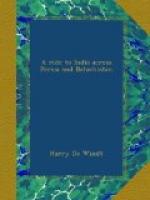The sight of Dhaira, on the morning of the 31st, relieved us of all further anxiety. This fertile plain, about fifteen miles long by ten broad, is bounded on the north-west by a chain of limestone mountains, the name of which I was unable to ascertain. Here for the second time since Beila we found a village and traces of inhabitants, the former encircled for a considerable distance by fields of maize and barley, enclosed by neat banks and hedges—a grateful contrast to the desolate waste behind us. It was the most perfect oasis imaginable. Shady forest trees and shrubs surrounded us on every side, a clear stream of running water fringed with ferns and wild flowers rippled through our camp, while the poor half-starved horses of the escort revelled in the long, rich grass. Hard by a cluster of three or four leaf huts, half hidden in a grove of date palms, lay (part of) the little village of Dhaira, deserted at this busy hour of the day save by women and children. The latter fled upon our arrival, and did not reappear until the evening, when the return of the men reassured them sufficiently to approach our tents and look upon the strange and unwelcome features of the Farangi without fear.
From here, by advice of the Wazir of Beila, a messenger was despatched to Malak, at Gwarjak, twenty miles distant, requesting permission to travel through his dominions. I resolved to proceed no further without the chief’s sanction, or to afford him in any way an excuse for making himself unpleasant. In the mean time, arms and accoutrements were looked to, and the escort cleaned and smartened up as well as circumstances would permit. The natives overcame their shyness next morning, and brought us goat’s milk and “rogan,” or clarified butter. The Baluchis seldom eat meat, their food principally consisting of cakes or bread made of grain, with buttermilk and rice. A favourite preparation known as “shalansh,” and called “krout” by the Afghans, is made by boiling buttermilk till the original quantity is reduced by half. The remainder is then strained through a thick felt bag, in the sun. When the draining ceases, the mass in the bag is formed into small lumps dried hard by the sun’s rays. When required for use these lumps are pounded and placed in warm water, where they are worked by the hands until dissolved. The thickened fluid is then boiled with rogan and eaten with bread.
Assafoetida, indigenous to the country, is largely used among all classes for flavouring dishes. So much is this noxious plant liked by Baluchis, that it goes by the name of “khush-khorak,” or pleasant food. At Kelat, in the palace of the Khan, I was offered it pickled, but it is usually eaten stewed in butter.




